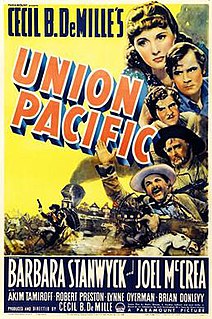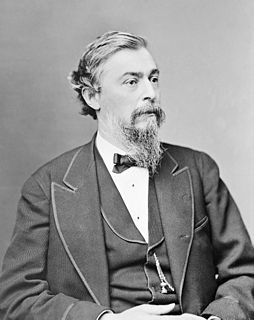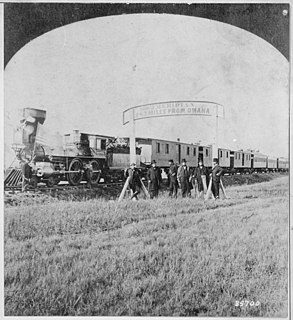
The Central Pacific Railroad (CPRR) was a rail company chartered by U.S. Congress in 1862 to build a railroad eastwards from Sacramento, California, to complete the western part of the "First transcontinental railroad" in North America. Incorporated in 1861, CPRR ceased operation in 1885 when it was acquired by Southern Pacific Railroad as a leased line.

North America's first transcontinental railroad was a 1,911-mile (3,075 km) continuous railroad line constructed between 1863 and 1869 that connected the existing eastern U.S. rail network at Council Bluffs, Iowa with the Pacific coast at the Oakland Long Wharf on San Francisco Bay. The rail line was built by three private companies over public lands provided by extensive US land grants. Building was financed by both state and US government subsidy bonds as well as by company issued mortgage bonds. The Western Pacific Railroad Company built 132 miles (212 km) of track from the road's western terminus at Alameda/Oakland to Sacramento, California. The Central Pacific Railroad Company of California (CPRR) constructed 690 miles (1,110 km) east from Sacramento to Promontory Summit, Utah Territory. The Union Pacific Railroad (UPRR) built 1,085 miles (1,746 km) from the road's eastern terminus at the Missouri River settlements of Council Bluffs and Omaha, Nebraska westward to Promontory Summit.

A transcontinental railroad or transcontinental railway is contiguous railroad trackage, that crosses a continental land mass and has terminals at different oceans or continental borders. Such networks can be via the tracks of either a single railroad or over those owned or controlled by multiple railway companies along a continuous route. Although Europe is crisscrossed by railways, the railroads within Europe are usually not considered transcontinental, with the possible exception of the historic Orient Express. Transcontinental railroads helped open up unpopulated interior regions of continents to exploration and settlement that would not otherwise have been feasible. In many cases they also formed the backbones of cross-country passenger and freight transportation networks. Many of them continue to have an important role in freight transportation and some like the Trans-Siberian Railway even have passenger trains going from one end to the other.

The Union Pacific Railroad, legally Union Pacific Railroad Company and often called simply Union Pacific, is a freight-hauling railroad that operates 8,300 locomotives over 32,200 miles (51,800 km) routes in 23 U.S. states west of Chicago and New Orleans. Union Pacific is the second largest railroad in the United States after BNSF, with which it shares a duopoly on transcontinental freight rail lines in the Western, Midwestern and Southern United States.

Promontory is an area of high ground in Box Elder County, Utah, United States, 32 mi (51 km) west of Brigham City and 66 mi (106 km) northwest of Salt Lake City. Rising to an elevation of 4,902 feet (1,494 m) above sea level, it lies to the north of the Promontory Mountains and the Great Salt Lake. It is notable as the location of Promontory Summit, where the First transcontinental railroad from Sacramento to Omaha in the United States was officially completed on May 10, 1869. The location is sometimes confused with Promontory Point, a location further south along the southern tip of the Promontory Mountains. Both locations are significant to the Overland Route, Promontory Summit is where the original, abandoned alignment crossed the Promontory Mountains while the modern alignment, called the Lucin Cutoff, crosses the mountains at Promontory Point.

The golden spike is the ceremonial 17.6-karat gold final spike driven by Leland Stanford to join the rails of the First transcontinental railroad across the United States connecting the Central Pacific Railroad from Sacramento and the Union Pacific Railroad from Omaha on May 10, 1869, at Promontory Summit, Utah Territory. The term last spike has been used to refer to one driven at the usually ceremonial completion of any new railroad construction projects, particularly those in which construction is undertaken from two disparate origins towards a common meeting point. The spike is now displayed in the Cantor Arts Center at Stanford University.

Andrew Joseph Russell was a 19th-century photographer of the American Civil War and the Union Pacific Railroad. Russell photographed construction of the Union Pacific (UP) in 1868 and 1869.

Grenville Mellen Dodge was a Union Army officer on the frontier and a pioneering figure in military intelligence during the Civil War, who served as Ulysses S. Grant's intelligence chief in the Western Theater. He served in several notable assignments, including command of the XVI Corps during the Atlanta Campaign.
Ernest James Haycox was an American writer of Western fiction.

Union Pacific is a 1939 American Western drama directed by Cecil B. DeMille and starring Barbara Stanwyck, Joel McCrea and Robert Preston. Based on the 1936 novel Trouble Shooter by Western fiction author Ernest Haycox, the film is about the building of the eponymous railroad across the American West. Haycox based his novel upon the experiences of civil engineer Charles H. Sharman, who worked on the railroad from its start in Omaha, Nebraska in 1866 until the golden spike ceremony on May 10, 1869 to commemorate the joining of the Central Pacific and Union Pacific railroads at Promontory Summit, Utah Territory. The film recreates the event using the same 1869 golden spike, on loan from Stanford University.

Thomas Clark Durant was an American physician, businessman, and financier. He was vice-president of the Union Pacific Railroad (UP) in 1869 when it met with the Central Pacific railroad at Promontory Summit in Utah Territory. He created the financial structure that led to the Crédit Mobilier scandal. He was interested in hotels in the Adirondacks and once owned the yacht Idler.

John Stephen "Jack" Casement was a general and brigade commander in the Union Army during the American Civil War and a noted railroad contractor and civil engineer. He directed the construction of the Union Pacific's section of the Transcontinental Railroad, which linked the Western United States with the East.

Union Pacific No. 119 was a 4-4-0 steam locomotive made famous for meeting the Central Pacific Railroad's Jupiter at Promontory Summit, Utah, during the Golden Spike ceremony commemorating the completion of the First transcontinental railroad in 1869. The locomotive was built by Rogers Locomotive and Machine Works of Paterson, New Jersey in 1868, along with numbers 116, 117, 118 and 120. The original was scrapped in 1903, but a replica now operates at the Golden Spike National Historical Park.
The Sioux City and Pacific Railroad was a railroad in the U.S. states of Iowa and Nebraska. Built as a connection from Sioux City, Iowa to the Union Pacific Railroad at Fremont, Nebraska, it became part of the Chicago and North Western Railway system in the 1880s, and is now a main line of the Union Pacific (UP). The east–west portion from Fremont to Missouri Valley, Iowa, is the Blair Subdivision, carrying mainly westbound UP trains, and the line from California Junction, Iowa north to Sioux City is the Sioux City Subdivision.

Hezekiah Bissell was a leading and well known nineteenth century American railroad engineer, civil engineer, and railroad maintenance of way manager for a number of railroads in the Northeastern United States, including the Cleveland, Cincinnati, Chicago and St. Louis Railway, Eastern Railroad of Massachusetts, and the Boston & Maine.
Herbert Melville "Hub" Hoxie was a pioneer, abolitionist, railroad executive and the first Republican United States Marshal in the State of Iowa during the American Civil War. He is closely associated with Jay Gould, Grenville Dodge and the early Republican Party.

The history of the Union Pacific Railroad stretches from 1862 to the present. For operations of the current railroad, see Union Pacific Railroad; for the holding company that owns the current railroad, see Union Pacific Corporation.

Marshall Farnam Hurd (1823–1903) was an American civil engineer who was part of the effort to build the Union Pacific railroad to Promontory Point, Utah in 1869. Hurd was present at the Golden spike ceremony on May 10, 1869, connecting the Central Pacific and Union Pacific railroads at Promontory Summit, Utah Territory. Hurd was also in the Russell photograph of the same date

James Armstrong Evans (1827-1887) was a British-born civil engineer who was part of the effort to build the Union Pacific railroad to Promontory Point, Utah in 1869. Evans was present at the Golden spike ceremony on May 10, 1869, connecting the Central Pacific and Union Pacific railroads at Promontory Summit, Utah Territory. Evans was also in the Russell photograph of the same date

















